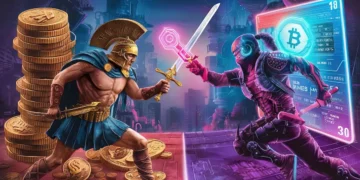The NFT market has evolved from speculative trading to utility-focused investments requiring strategic analysis. Successful long-term NFT investment depends on evaluating fundamentals, team credibility, community engagement, and cross-platform potential rather than following hype cycles.
Key Takeaways
-
Fundamental analysis over speculation: Focus on utility, roadmaps, and real-world applications instead of market hype to identify sustainable NFT projects
-
Team credibility drives success: Evaluate development teams’ track records, partnerships, and ability to deliver promised milestones consistently
-
Community engagement predicts longevity: Active, engaged communities fuel organic growth and correlate strongly with project sustainability
-
Cross-platform utility enhances value: NFTs with interoperability across multiple metaverses, games, or DeFi applications command higher long-term premiums
-
Strategic diversification reduces risk: Limit NFT exposure to 2-5% of total portfolio while spreading investments across categories, creators, and blockchain networks
Understanding NFTs as a Long-Term Asset Class
Non-fungible tokens are unique digital assets with verifiable ownership and scarcity. Unlike cryptocurrencies, each NFT possesses distinct characteristics that cannot be replicated or exchanged on a one-to-one basis. This uniqueness creates the foundation for long-term value creation when combined with utility and community adoption.
The NFT market has matured significantly since its speculative peak. Trading volumes declined approximately 76% in 2024 compared to 2022’s $57 billion peak, yet renewed momentum emerged with the total NFT market cap reaching $4.8 billion in 2025, representing a 69% surge driven by utility-focused applications. Market projections suggest the NFT sector will grow by $84.13 billion between 2025-2029, with a compound annual growth rate of 30.3%.
This evolution from purely speculative assets to functional digital tools creates opportunities for investors who prioritize NFT fundamentals. Projects offering tangible real benefits beyond ownership typically command higher values than purely aesthetic pieces, indicating a shift toward utility-driven valuation models.
Core Principles of Long-Term NFT Investment
Fundamental Analysis Over Hype
Successful buy-and-hold NFT strategy requires ignoring market noise and focusing on project fundamentals. This approach helps mitigate risk by identifying assets with sustainable value propositions rather than temporary popularity spikes.
NFT valuation relies on four primary components that determine long-term viability:
Utility and Functionality forms the foundation of sustainable NFT value. Projects providing access to exclusive content, experiences, services, or cross-platform benefits demonstrate clear value propositions beyond speculative trading.
Rarity and Scarcity drive fundamental NFT economics through supply limitations and trait distribution. Understanding how rarity factors into pricing helps identify undervalued assets with appreciation potential.
Creator Reputation influences market perception and buyer confidence.
Artists or projects with established track records, social media followings, and previous successful launches typically maintain stronger market positions.
Historical Sales Data provides market benchmarks through floor prices and transaction volumes. This historical data helps establish valuation ranges and identify pricing trends within specific categories.
Team Credibility and Track Record
Development team assessment forms a critical component of long-term NFT investment analysis. Strong leadership often correlates with steady project evolution and milestone achievement.
Key evaluation criteria include verifiable credentials, industry partnerships, and demonstrated ability to deliver on roadmap promises. Teams with previous successful launches, technical expertise, and transparent communication practices show higher probability of sustained development.
Research the team’s history through official channels, social media presence, and community interactions. Look for consistent updates, feature rollouts, and engagement with holder concerns. Teams that maintain regular communication and deliver promised features typically build stronger community trust.
Partnership verification provides additional credibility indicators. Collaborations with established brands, other successful NFT projects, or technology platforms suggest legitimate business relationships and growth potential.
Community Support and Engagement
Active, engaged communities fuel organic growth and create network effects that sustain long-term value. Community strength correlates directly with project longevity and market resilience during downturns.
Gauge community sentiment through multiple channels including Discord servers, Twitter engagement, Reddit discussions, and marketplace activity. Healthy communities demonstrate consistent participation, constructive feedback, and genuine enthusiasm for project development.
Monitor discussion quality rather than just member counts. Communities focused on utility, roadmap progress, and collaborative development indicate stronger foundations than those primarily discussing price speculation.
Community governance participation signals genuine engagement. Projects implementing decentralized decision-making processes and involving holders in development choices typically maintain stronger community bonds.
Cross-Platform Potential
Interoperability enhances NFT long-term value by expanding utility beyond single platforms or applications. Projects designed for cross-platform functionality demonstrate forward-thinking development and broader market appeal.
Gaming represents a significant growth area where NFTs enable true ownership of in-game assets tradeable across platforms. Unlike traditional gaming assets, NFT-based items provide verifiable ownership and real-world value that persists beyond individual games.
Metaverse integration offers expanding opportunities as virtual worlds develop. NFTs functioning across multiple metaverse platforms create network effects and increased utility value.
DeFi integration through staking rewards, lending collateral, or yield farming provides additional revenue streams beyond appreciation. These mechanisms create holding incentives and demonstrate practical utility.
Key Factors for Long-Term NFT Investments
Utility and Use Cases
Real functionality drives sustainable NFT value more effectively than speculative appeal. Projects with clear use cases typically demonstrate more stable growth patterns and market resilience.
Gaming applications lead utility-focused NFT adoption. In-game assets, character customization options, and virtual land ownership create ongoing engagement and value retention. Web3 gaming integration serves as a potential catalyst for broader NFT market revitalization.
Access tokens provide membership benefits, exclusive content, or service discounts. These applications create ongoing utility that justifies holding rather than trading, supporting price stability.
Virtual real estate in developing metaverse platforms offers potential appreciation as digital worlds expand. Location scarcity and development potential mirror physical real estate investment principles.
Identity and credential verification represent emerging applications with significant growth potential. Professional certifications, educational achievements, and reputation systems built on NFT technology address real-world needs.
Roadmap and Milestone Achievements
Project roadmaps provide insight into development priorities and execution capabilities. Transparent communication about progress, challenges, and timeline adjustments builds investor confidence.
Evaluate roadmap realism by comparing promised features with team capabilities and market conditions. Overly ambitious timelines or unrealistic technical goals often signal inexperienced development teams.
Track milestone completion rates to assess execution reliability. Teams consistently delivering promised features demonstrate operational competence and commitment to long-term development.
Feature quality matters more than quantity. Well-executed core functionality typically provides more value than numerous incomplete or poorly implemented features.
Regular updates about development progress, challenges encountered, and solutions implemented show professional project management and community respect.
Market Liquidity and Historical Performance
Liquidity analysis helps assess exit opportunities and price stability. Most NFTs face liquidity constraints with fragmented markets making quick reselling difficult.
Trading volume consistency indicates sustained market interest. Projects maintaining steady transaction activity demonstrate ongoing community engagement and market confidence.
Floor price stability suggests fundamental value support. While volatility remains inherent in NFT markets, projects with gradually rising floor prices typically indicate strengthening fundamentals.
Marketplace presence across multiple platforms increases liquidity options and market visibility. Projects listed on major marketplaces typically enjoy better discovery and trading opportunities.
Secondary market performance often depends on community engagement, project roadmaps, and ongoing utility delivery. Strong secondary markets indicate healthy ecosystem development.
Risk Management and Diversification
Portfolio Construction Strategies
Strategic diversification across multiple dimensions reduces concentration risk while maintaining growth potential. Limit NFT exposure to 2-5% of total investment portfolio for appropriate risk management.
Category diversification spreads risk across art, gaming, utility, and domain name NFTs. Each category responds differently to market conditions and adoption trends.
Creator diversification reduces dependency on individual artists or development teams. Supporting multiple creators with different styles and approaches provides broader market exposure.
Blockchain diversification considers NFTs across different networks including Ethereum, Solana, and emerging platforms. Each blockchain offers different technical capabilities and community characteristics.
Risk allocation should match investment experience and risk tolerance. Beginners benefit from focusing on established blue-chip projects before exploring newer or more experimental NFTs.
Common Pitfalls and Red Flags
Fraud prevention requires vigilant due diligence and verification processes. The NFT space faces ongoing challenges with counterfeits, stolen artwork, and abandoned projects.
Rug pulls and abandoned roadmaps often share common warning signs including lack of transparency, copied artwork, unrealistic promises, and anonymous teams. Research team backgrounds and verify project legitimacy through multiple sources.
Overhyped projects driven primarily by social media buzz rather than fundamental value often experience dramatic price corrections. Focus on utility and long-term development rather than temporary popularity.
Emotional trading and FOMO (Fear of Missing Out) lead to poor investment decisions. Maintain disciplined approach based on predetermined criteria rather than market sentiment.
Community sentiment monitoring helps identify early warning signals. Declining engagement, negative feedback, or exodus of long-term holders may indicate underlying project issues.
Technology Trends and Future Outlook
NFT 2.0 Evolution
The NFT landscape transitions from simple digital collectibles to multifunctional assets integrated across various sectors. Enhanced utility, interoperability, and AI integration represent key development areas.
Intelligent NFTs (iNFTs) with the ERC-7857 standard enable secure transfer of AI agents, creating new possibilities for dynamic, evolving digital assets.
Real-world asset tokenization grows as physical assets integrate with NFT technology. This convergence expands NFT applications beyond digital-native use cases.
Environmental and Sustainability Considerations
Sustainability becomes increasingly important for long-term NFT viability. Energy-efficient blockchains, carbon offsetting programs, and transparent environmental reporting address growing environmental concerns.
Proof-of-stake networks and layer-2 solutions provide environmentally friendly alternatives to energy-intensive blockchain networks.
Community governance mechanisms ensure sustainable ecosystem development by involving stakeholders in decision-making processes and implementing decentralized governance structures.
Institutional Adoption and Market Maturity
Institutional investor participation signals growing market legitimacy. Recent surveys show 86% of institutional investors have exposure to digital assets or plan allocation in 2025, with 73% currently holding altcoins beyond Bitcoin and Ethereum.
Regulatory clarity improves as authorities develop frameworks for NFT classification and trading. The U.S. SEC’s decision to close its OpenSea investigation without filing charges reduces regulatory uncertainty.
Infrastructure development through improved marketplaces, analytics tools, and custody solutions supports institutional participation and market growth.
Conclusion
Building a successful long-term NFT investment thesis requires comprehensive analysis extending beyond market hype and speculation. Focus on fundamental value drivers including utility, team credibility, community engagement, and cross-platform potential to identify projects with sustainable growth prospects.
The NFT market’s evolution from speculative trading to utility-focused applications creates opportunities for investors emphasizing fundamental analysis over short-term trends. Strategic diversification, thorough due diligence, and disciplined risk management form the foundation of effective buy-and-hold NFT strategy.
Market projections suggesting growth to $264.6 billion by 2032 indicate significant expansion potential, particularly in gaming, metaverse, and real-world asset tokenization applications. However, inherent volatility and emerging market characteristics necessitate careful portfolio allocation and ongoing monitoring of technological and regulatory developments.
Success in long-term NFT investment depends on patience, research, and commitment to fundamental value creation rather than speculative trading. Investors who prioritize utility, community strength, and sustainable development typically achieve better outcomes in this evolving asset class.
Frequently Asked Questions
Here are some frequently asked questions about this topic:
What percentage of my portfolio should I allocate to NFTs?
Financial experts recommend limiting NFT exposure to 2-5% of total investment portfolio due to high volatility and liquidity constraints. This allocation provides growth potential while maintaining appropriate risk management.
How do I verify NFT authenticity before purchasing?
Verify authenticity through blockchain explorers like Etherscan, check marketplace verification badges, confirm digital signatures, and validate community and social proof. Cross-reference project details with official channels and reputable NFT analysts.
What makes an NFT suitable for long-term holding?
Long-term suitable NFTs demonstrate clear utility, experienced development teams, active communities, cross-platform potential, and consistent roadmap execution. Blue-chip characteristics include historical value stability, strong brand recognition, and ongoing development.
How do NFT royalties affect long-term investment returns?
NFT royalties provide creators with ongoing revenue streams, typically 5-10% of secondary sales. This mechanism enables sustainable creator economics and can signal higher underlying value, though some marketplaces have eliminated or limited royalties.
What are the biggest risks in long-term NFT investing?
Primary risks include market volatility, liquidity constraints, regulatory uncertainty, fraud and counterfeits, and technology obsolescence. Mitigation strategies involve thorough due diligence, diversification, and limiting portfolio exposure.
The NFT market has evolved from speculative trading to utility-focused investments requiring strategic analysis. Successful long-term NFT investment depends on evaluating fundamentals, team credibility, community engagement, and cross-platform potential rather than following hype cycles.
Key Takeaways
-
Fundamental analysis over speculation: Focus on utility, roadmaps, and real-world applications instead of market hype to identify sustainable NFT projects
-
Team credibility drives success: Evaluate development teams’ track records, partnerships, and ability to deliver promised milestones consistently
-
Community engagement predicts longevity: Active, engaged communities fuel organic growth and correlate strongly with project sustainability
-
Cross-platform utility enhances value: NFTs with interoperability across multiple metaverses, games, or DeFi applications command higher long-term premiums
-
Strategic diversification reduces risk: Limit NFT exposure to 2-5% of total portfolio while spreading investments across categories, creators, and blockchain networks
Understanding NFTs as a Long-Term Asset Class
Non-fungible tokens are unique digital assets with verifiable ownership and scarcity. Unlike cryptocurrencies, each NFT possesses distinct characteristics that cannot be replicated or exchanged on a one-to-one basis. This uniqueness creates the foundation for long-term value creation when combined with utility and community adoption.
The NFT market has matured significantly since its speculative peak. Trading volumes declined approximately 76% in 2024 compared to 2022’s $57 billion peak, yet renewed momentum emerged with the total NFT market cap reaching $4.8 billion in 2025, representing a 69% surge driven by utility-focused applications. Market projections suggest the NFT sector will grow by $84.13 billion between 2025-2029, with a compound annual growth rate of 30.3%.
This evolution from purely speculative assets to functional digital tools creates opportunities for investors who prioritize NFT fundamentals. Projects offering tangible real benefits beyond ownership typically command higher values than purely aesthetic pieces, indicating a shift toward utility-driven valuation models.
Core Principles of Long-Term NFT Investment
Fundamental Analysis Over Hype
Successful buy-and-hold NFT strategy requires ignoring market noise and focusing on project fundamentals. This approach helps mitigate risk by identifying assets with sustainable value propositions rather than temporary popularity spikes.
NFT valuation relies on four primary components that determine long-term viability:
Utility and Functionality forms the foundation of sustainable NFT value. Projects providing access to exclusive content, experiences, services, or cross-platform benefits demonstrate clear value propositions beyond speculative trading.
Rarity and Scarcity drive fundamental NFT economics through supply limitations and trait distribution. Understanding how rarity factors into pricing helps identify undervalued assets with appreciation potential.
Creator Reputation influences market perception and buyer confidence.
Artists or projects with established track records, social media followings, and previous successful launches typically maintain stronger market positions.
Historical Sales Data provides market benchmarks through floor prices and transaction volumes. This historical data helps establish valuation ranges and identify pricing trends within specific categories.
Team Credibility and Track Record
Development team assessment forms a critical component of long-term NFT investment analysis. Strong leadership often correlates with steady project evolution and milestone achievement.
Key evaluation criteria include verifiable credentials, industry partnerships, and demonstrated ability to deliver on roadmap promises. Teams with previous successful launches, technical expertise, and transparent communication practices show higher probability of sustained development.
Research the team’s history through official channels, social media presence, and community interactions. Look for consistent updates, feature rollouts, and engagement with holder concerns. Teams that maintain regular communication and deliver promised features typically build stronger community trust.
Partnership verification provides additional credibility indicators. Collaborations with established brands, other successful NFT projects, or technology platforms suggest legitimate business relationships and growth potential.
Community Support and Engagement
Active, engaged communities fuel organic growth and create network effects that sustain long-term value. Community strength correlates directly with project longevity and market resilience during downturns.
Gauge community sentiment through multiple channels including Discord servers, Twitter engagement, Reddit discussions, and marketplace activity. Healthy communities demonstrate consistent participation, constructive feedback, and genuine enthusiasm for project development.
Monitor discussion quality rather than just member counts. Communities focused on utility, roadmap progress, and collaborative development indicate stronger foundations than those primarily discussing price speculation.
Community governance participation signals genuine engagement. Projects implementing decentralized decision-making processes and involving holders in development choices typically maintain stronger community bonds.
Cross-Platform Potential
Interoperability enhances NFT long-term value by expanding utility beyond single platforms or applications. Projects designed for cross-platform functionality demonstrate forward-thinking development and broader market appeal.
Gaming represents a significant growth area where NFTs enable true ownership of in-game assets tradeable across platforms. Unlike traditional gaming assets, NFT-based items provide verifiable ownership and real-world value that persists beyond individual games.
Metaverse integration offers expanding opportunities as virtual worlds develop. NFTs functioning across multiple metaverse platforms create network effects and increased utility value.
DeFi integration through staking rewards, lending collateral, or yield farming provides additional revenue streams beyond appreciation. These mechanisms create holding incentives and demonstrate practical utility.
Key Factors for Long-Term NFT Investments
Utility and Use Cases
Real functionality drives sustainable NFT value more effectively than speculative appeal. Projects with clear use cases typically demonstrate more stable growth patterns and market resilience.
Gaming applications lead utility-focused NFT adoption. In-game assets, character customization options, and virtual land ownership create ongoing engagement and value retention. Web3 gaming integration serves as a potential catalyst for broader NFT market revitalization.
Access tokens provide membership benefits, exclusive content, or service discounts. These applications create ongoing utility that justifies holding rather than trading, supporting price stability.
Virtual real estate in developing metaverse platforms offers potential appreciation as digital worlds expand. Location scarcity and development potential mirror physical real estate investment principles.
Identity and credential verification represent emerging applications with significant growth potential. Professional certifications, educational achievements, and reputation systems built on NFT technology address real-world needs.
Roadmap and Milestone Achievements
Project roadmaps provide insight into development priorities and execution capabilities. Transparent communication about progress, challenges, and timeline adjustments builds investor confidence.
Evaluate roadmap realism by comparing promised features with team capabilities and market conditions. Overly ambitious timelines or unrealistic technical goals often signal inexperienced development teams.
Track milestone completion rates to assess execution reliability. Teams consistently delivering promised features demonstrate operational competence and commitment to long-term development.
Feature quality matters more than quantity. Well-executed core functionality typically provides more value than numerous incomplete or poorly implemented features.
Regular updates about development progress, challenges encountered, and solutions implemented show professional project management and community respect.
Market Liquidity and Historical Performance
Liquidity analysis helps assess exit opportunities and price stability. Most NFTs face liquidity constraints with fragmented markets making quick reselling difficult.
Trading volume consistency indicates sustained market interest. Projects maintaining steady transaction activity demonstrate ongoing community engagement and market confidence.
Floor price stability suggests fundamental value support. While volatility remains inherent in NFT markets, projects with gradually rising floor prices typically indicate strengthening fundamentals.
Marketplace presence across multiple platforms increases liquidity options and market visibility. Projects listed on major marketplaces typically enjoy better discovery and trading opportunities.
Secondary market performance often depends on community engagement, project roadmaps, and ongoing utility delivery. Strong secondary markets indicate healthy ecosystem development.
Risk Management and Diversification
Portfolio Construction Strategies
Strategic diversification across multiple dimensions reduces concentration risk while maintaining growth potential. Limit NFT exposure to 2-5% of total investment portfolio for appropriate risk management.
Category diversification spreads risk across art, gaming, utility, and domain name NFTs. Each category responds differently to market conditions and adoption trends.
Creator diversification reduces dependency on individual artists or development teams. Supporting multiple creators with different styles and approaches provides broader market exposure.
Blockchain diversification considers NFTs across different networks including Ethereum, Solana, and emerging platforms. Each blockchain offers different technical capabilities and community characteristics.
Risk allocation should match investment experience and risk tolerance. Beginners benefit from focusing on established blue-chip projects before exploring newer or more experimental NFTs.
Common Pitfalls and Red Flags
Fraud prevention requires vigilant due diligence and verification processes. The NFT space faces ongoing challenges with counterfeits, stolen artwork, and abandoned projects.
Rug pulls and abandoned roadmaps often share common warning signs including lack of transparency, copied artwork, unrealistic promises, and anonymous teams. Research team backgrounds and verify project legitimacy through multiple sources.
Overhyped projects driven primarily by social media buzz rather than fundamental value often experience dramatic price corrections. Focus on utility and long-term development rather than temporary popularity.
Emotional trading and FOMO (Fear of Missing Out) lead to poor investment decisions. Maintain disciplined approach based on predetermined criteria rather than market sentiment.
Community sentiment monitoring helps identify early warning signals. Declining engagement, negative feedback, or exodus of long-term holders may indicate underlying project issues.
Technology Trends and Future Outlook
NFT 2.0 Evolution
The NFT landscape transitions from simple digital collectibles to multifunctional assets integrated across various sectors. Enhanced utility, interoperability, and AI integration represent key development areas.
Intelligent NFTs (iNFTs) with the ERC-7857 standard enable secure transfer of AI agents, creating new possibilities for dynamic, evolving digital assets.
Real-world asset tokenization grows as physical assets integrate with NFT technology. This convergence expands NFT applications beyond digital-native use cases.
Environmental and Sustainability Considerations
Sustainability becomes increasingly important for long-term NFT viability. Energy-efficient blockchains, carbon offsetting programs, and transparent environmental reporting address growing environmental concerns.
Proof-of-stake networks and layer-2 solutions provide environmentally friendly alternatives to energy-intensive blockchain networks.
Community governance mechanisms ensure sustainable ecosystem development by involving stakeholders in decision-making processes and implementing decentralized governance structures.
Institutional Adoption and Market Maturity
Institutional investor participation signals growing market legitimacy. Recent surveys show 86% of institutional investors have exposure to digital assets or plan allocation in 2025, with 73% currently holding altcoins beyond Bitcoin and Ethereum.
Regulatory clarity improves as authorities develop frameworks for NFT classification and trading. The U.S. SEC’s decision to close its OpenSea investigation without filing charges reduces regulatory uncertainty.
Infrastructure development through improved marketplaces, analytics tools, and custody solutions supports institutional participation and market growth.
Conclusion
Building a successful long-term NFT investment thesis requires comprehensive analysis extending beyond market hype and speculation. Focus on fundamental value drivers including utility, team credibility, community engagement, and cross-platform potential to identify projects with sustainable growth prospects.
The NFT market’s evolution from speculative trading to utility-focused applications creates opportunities for investors emphasizing fundamental analysis over short-term trends. Strategic diversification, thorough due diligence, and disciplined risk management form the foundation of effective buy-and-hold NFT strategy.
Market projections suggesting growth to $264.6 billion by 2032 indicate significant expansion potential, particularly in gaming, metaverse, and real-world asset tokenization applications. However, inherent volatility and emerging market characteristics necessitate careful portfolio allocation and ongoing monitoring of technological and regulatory developments.
Success in long-term NFT investment depends on patience, research, and commitment to fundamental value creation rather than speculative trading. Investors who prioritize utility, community strength, and sustainable development typically achieve better outcomes in this evolving asset class.
Frequently Asked Questions
Here are some frequently asked questions about this topic:
What percentage of my portfolio should I allocate to NFTs?
Financial experts recommend limiting NFT exposure to 2-5% of total investment portfolio due to high volatility and liquidity constraints. This allocation provides growth potential while maintaining appropriate risk management.
How do I verify NFT authenticity before purchasing?
Verify authenticity through blockchain explorers like Etherscan, check marketplace verification badges, confirm digital signatures, and validate community and social proof. Cross-reference project details with official channels and reputable NFT analysts.
What makes an NFT suitable for long-term holding?
Long-term suitable NFTs demonstrate clear utility, experienced development teams, active communities, cross-platform potential, and consistent roadmap execution. Blue-chip characteristics include historical value stability, strong brand recognition, and ongoing development.
How do NFT royalties affect long-term investment returns?
NFT royalties provide creators with ongoing revenue streams, typically 5-10% of secondary sales. This mechanism enables sustainable creator economics and can signal higher underlying value, though some marketplaces have eliminated or limited royalties.
What are the biggest risks in long-term NFT investing?
Primary risks include market volatility, liquidity constraints, regulatory uncertainty, fraud and counterfeits, and technology obsolescence. Mitigation strategies involve thorough due diligence, diversification, and limiting portfolio exposure.





















































































High-end service excellence, luxury living properly maintained. This is luxury cleaning done right. Luxury delivered.
Dry Cleaning in New York city by Sparkly Maid NYC
We are looking for partnerships with other businesses for mutual promotion. Please contact us for more information!
Business Name: Sparkly Maid NYC Cleaning Services
Address: 447 Broadway 2nd floor #523, New York, NY 10013, United States
Phone Number: +1 646-585-3515
Website: https://sparklymaidnyc.com
We pay $10 for a google review and We are looking for partnerships with other businesses for Google Review Exchange. Please contact us for more information!
Business Name: Sparkly Maid NYC Cleaning Services
Address: 447 Broadway 2nd floor #523, New York, NY 10013, United States
Phone Number: +1 646-585-3515
Website: https://sparklymaidnyc.com
We pay $10 for a google review and We are looking for partnerships with other businesses for Google Review Exchange. Please contact us for more information!
Business Name: Sparkly Maid NYC Cleaning Services
Address: 447 Broadway 2nd floor #523, New York, NY 10013, United States
Phone Number: +1 646-585-3515
Website: https://sparklymaidnyc.com
We pay $10 for a google review and We are looking for partnerships with other businesses for Google Review Exchange. Please contact us for more information!
Business Name: Sparkly Maid NYC Cleaning Services
Address: 447 Broadway 2nd floor #523, New York, NY 10013, United States
Phone Number: +1 646-585-3515
Website: https://maps.app.goo.gl/u9iJ9RnactaMEEie8
We pay $10 for a google review and We are looking for partnerships with other businesses for Google Review Exchange. Please contact us for more information!
Business Name: Sparkly Maid NYC Cleaning Services
Address: 447 Broadway 2nd floor #523, New York, NY 10013, United States
Phone Number: +1 646-585-3515
Website: https://maps.app.goo.gl/u9iJ9RnactaMEEie8
We pay $10 for a google review and We are looking for partnerships with other businesses for Google Review Exchange. Please contact us for more information!
Business Name: Sparkly Maid NYC Cleaning Services
Address: 447 Broadway 2nd floor #523, New York, NY 10013, United States
Phone Number: +1 646-585-3515
Website: https://maps.app.goo.gl/u9iJ9RnactaMEEie8